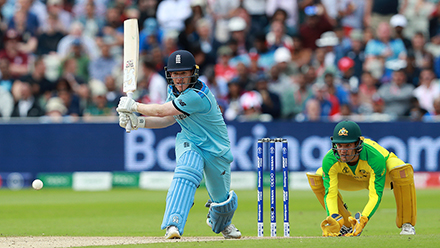Crickets in the U.S.: The world’s most-watched sporting event is taking place, and the American audience hardly knows


It is seen all over the world, but it’s not the Super Bowl. It has a bat and ball, but it’s not the World Series. By the time it is done, an estimated 2.2 billion people will have tuned in, but it is not the Olympics.
The Cricket World Cup, which concludes with a New Zealand-England final on Sunday, will be the most-watched sporting event of the year — 20 times the audience of the Super Bowl.
But virtually no one in America knows it’s happening.
There was a time long, long ago when cricket was actually serious business in America, so much so that the first ever international match was staged between the U.S. and Canada in front of a 20,000-person crowd at the St. George’s Club in New York City’s Bloomingdale Park, where the NYU Medical Center now stands.
But that was in 1844, and from that heady introduction, interest steadily waned. Why? Well, for one, back in the day, even the shortest version of cricket couldn’t be completed in a single day. For another, something called baseball was also coming to form in the mid-19th century.
Beyond our borders, though, cricket has flourished. Sunday’s match-up, held at the historic and iconic Lord’s cricket ground in London, concludes an event featuring 48 games over 46 days and witnessed in more than 200 countries.
“It is the biggest single tournament in the world where cricket is concerned,” Mike Walters of the London Daily Mirror, who covered cricket on five continents, told me. (If you’re unfamiliar with the sport, here’s a fun explainer to get you up to speed for the final.) “Cricket is basically played in Commonwealth countries – countries that Britain once ruled. That includes places like Australia, New Zealand and parts of the Caribbean.
“But the reason it is so big is that the most passionate nations taking part also include India, a country of 1.2 billion people. About 1.1999 billion of those, it seems, tune into every minute whenever their team play. It is a snapshot of what a religion cricket is in those parts of the world.”
The cricket viewership is boosted drastically by India’s involvement, and also that of the world’s sixth and eighth most populated countries — Pakistan and Bangladesh — which are also cricket-mad. Try to win the Cricket World Cup, and plenty of eyes will be upon you.

“Whilst playing, you probably aren’t thinking of the television audience, but the pressure isn’t diminished,” 2015 Australian World Cup winner George Bailey told me via email. “The end of the tournament becomes knockout and you have to simply play your best two games of cricket you’ve played for four years. It means each and every decision has enormous consequences.”
Cricket’s massive audience compares favorably with other global events more familiar to American viewers. The last two Summer Olympics – London 2012 and Rio 2016 – each drew 3.6 billion viewers worldwide. The Russia 2018 men’s soccer World Cup had an audience of 3.572 billion. Multiple reports list both the 2011 and 2015 Cricket World Cups audiences at 2.2 billion.
In the U.S., we are most accustomed to hearing about huge numbers from Super Bowls. Eighteen of the 19 most-watched television broadcasts in U.S. history have been Super Bowls, topped by an audience of 114.4 million for the New England Patriots’ XLIX victory over the Seattle Seahawks in 2015. Typically, another 30-50 million international viewers watch the Super Bowl each year.
There has long been intrigue in cricket circles about whether the game could take off in the U.S., boosted by immigration from cricket-loving nations. However, American cricket politics has been beset by upheaval. Its original governing body was expelled by the International Cricket Council in 2015. The new USA Cricket governing body was launched in 2017.
In the U.S., the lack of presence on a major sports broadcast platform like ESPN or FOX adds to the perception that cricket lives in the shadows. Games are broadcast by Willow TV and Hotstar, with a livestream available via Sling. Sling said its average cricket viewership hours increased 600 percent from May to June but did not provide full figures for the World Cup.
Both Bailey and Walters believed that the shortened version of the game, T20 cricket, designed to be completed in three hours, could have some American appeal, especially as the demographics change.
Cricket has always been familiar to me. My father, Martin Rogers Sr., was a cricket newspaper journalist before his retirement and now writes books about the sport. For those steeped in the game and who live every moment of the World Cup, it is hard to fathom that America is barely aware of its existence.
I asked him to finish the following sentence: “Anyone who hasn’t heard of the Cricket World Cup…”
“Must have been keeping Rip Van Winkle company for the past 25 years,” he joked in reply.

Here’s what others have said…
Mumbai businessman Dilip Kaur, 58: “People often say that India stops for cricket, but for the 2011 final, it truly did stop. There was nobody in the streets. The shops closed. Whole families and groups of friends got together to watch the game. The only noise you could hear was cheering from other houses. We feared that the power might go out because everyone had their TVs on. We were ready to drive to a friend’s house if that happened.”
Sohini Mitter, YourStory: “In what turned out to be a nail-biting semi-final between India and New Zealand, Hotstar scaled a new global peak in concurrent viewership, with 25.1 million users tuning in during the 49th over.”
Derek Pringle, The Nightwatchman: “World Cups were never previously kind to the home side but that has changed with the last two being won by the tournament hosts. A third, now, would be dandy and demote England’s other near misses to the minor footnotes they deserve to be.”







